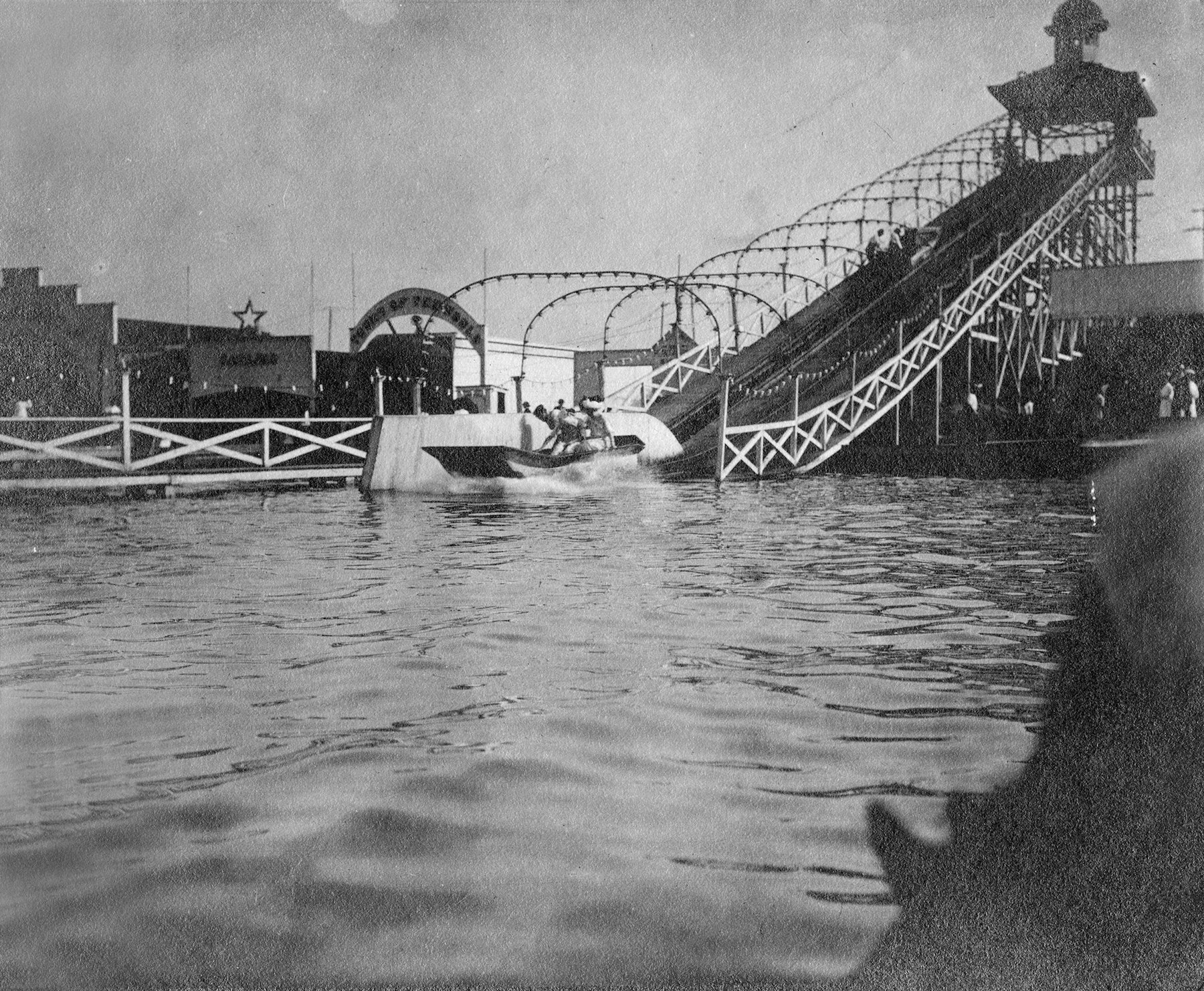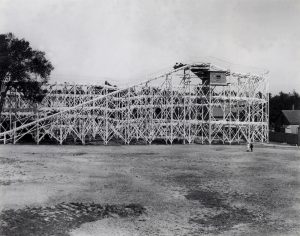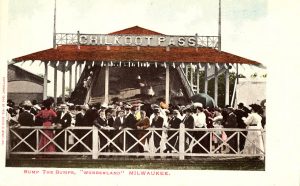Amusement parks were important commercial leisure institutions in late nineteenth and early twentieth century Milwaukee. The development of such spaces with thrilling rides, midway games, stunt exhibitions, and other spectacles reflected a growing demand for new forms of American mass cultural amusement. The Americanization of Milwaukee’s large working-class immigrant communities found them enjoying local amusement parks like those found at New York’s Coney Island and Chicago’s 1893 World’s Columbian Exhibition.
Milwaukee was already home to commercial park-like spaces in brewery-run beer gardens; the city’s amusement parks grew out of these traditional institutions. National Park, located at the present site of National Avenue and Layton Boulevard on the city’s South Side, installed Milwaukee’s first roller coaster in 1885.[1] Pabst Park, located on the present corner of Martin Luther King, Jr. Drive and Burleigh Street, installed roller coasters, a “Katzenjammer castle” funhouse, a scenic miniature railway, an “underground” riverboat ride, and various popular midway games in the 1890s.[2]
New parks dedicated solely to mass amusement attractions emerged in Milwaukee by the mid-1890s—typically along major streetcar lines. Opened on the bluffs above the Milwaukee River near the North Avenue bridge in 1896, Shoot-the-Chutes Park featured a large boat chute that riders “shot” down into the water below, replicating the famous ride from Coney Island’s Luna Park.[3] Wonderland (originally named Coney Island and later Ravenna Park) opened in 1900 on the site of a former beer garden along on Oakland Avenue in Shorewood (now the site of Hubbard Park). It featured several attractions made popular by the original Coney Island, including a “Shoot the Chutes,” circle swing, “Bump the Bumps,” and roller coasters, as well as several midway attractions such as a collection of displays called the “Tour of the World.”[4] A similar, but short-lived amusement park, White City, opened at Fiftieth and Vliet Streets in 1906.[5] These parks adopted not only the attractions, but also the aesthetics of Coney Island: large, ornate, and whitewashed buildings festooned with flags and brightly lit with electric light at night.
Most of Milwaukee’s amusement parks closed as their popularity faded through the 1910s. An expanding county park system worked to accommodate the leisure needs of Milwaukee residents, and national Prohibition removed alcohol from commercial entertainment.[6] However, one popular Milwaukee area amusement park, Muskego Beach Amusement Park, remained in operation along the shore of Little Muskego Lake in the city of Muskego into the late twentieth century. Renamed DandiLion Park in 1968, the park featured a variety of rides, including the popular Tail Spin roller coaster, games, and a music venue. The park closed in 1977 after the larger Great America amusement park opened in nearby Gurnee, Illinois, which drew many customers away.[7]
Footnotes [+]
- ^ John Gurda, “National Park: Where Milwaukee Went for Thrills 100 Years Ago,” Milwaukee Journal Sentinel, August 9, 2014.
- ^ Milwaukee Sentinel, June 11, 1885, 3; Harry H. Anderson, “Recreation, Entertainment, and Open Space: Park Traditions in Milwaukee County,” in Trading Post to Metropolis: Milwaukee County’s First 150 Years, ed. Ralph M. Aderman (Milwaukee: Milwaukee County Historical Society, 1987), 261.
- ^ John F. Kasson, Amusing the Million: Coney Island at the Turn of the Century (New York, NY: Hill and Wang, 1978), 78.
- ^ Danny Benson, “MKE in Wonderland: How an Amusement Park Created the Village of Shorewood,” MKE Memoirs, Milwaukee County Historical Society, accessed October 27, 2018.
- ^ Larry Widen and Judi Anderson, Silver Screens: A Pictorial History of Milwaukee’s Movie Theaters (Madison, WI: Wisconsin Historical Society, 2007), 27; Milwaukee Sentinel, July 1, 1906, section 3, 12.
- ^ Joseph B. Walzer, “Suds and Solidarity: Outdoor Leisure Spaces and Working Class Identities in Milwaukee, 1880-1925” (MA thesis, University of Wisconsin-Milwaukee, 2009), 141-42.
- ^ “DandiLion Park,” Muskego Historical Society website, last accessed December 3, 2018.
For Further Reading
Anderson, Harry H. “Recreation, Entertainment, and Open Space: Park Traditions in Milwaukee County.” Trading Post to Metropolis: Milwaukee County’s First 150 Years, edited by Ralph M. Aderman. Milwaukee: Milwaukee County Historical Society, 1987.
Walzer, Joseph B. “Suds and Solidarity: Outdoor Leisure Spaces and Working Class Identities in Milwaukee, 1880-1925.” MA, University of Wisconsin-Milwaukee, 2009.




0 Comments
Please keep your community civil. All comments must follow the Encyclopedia of Milwaukee Community rules and terms of use, and will be moderated prior to posting. Encyclopedia of Milwaukee reserves the right to use the comments we receive, in whole or in part, and to use the commenter's name and location, in any medium. See also the Copyright, Privacy, and Terms & Conditions.
Have a suggestion for a new topic? Please use the Site Contact Form.